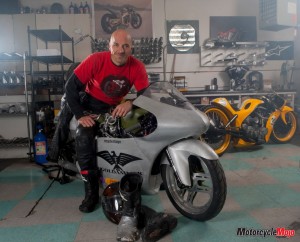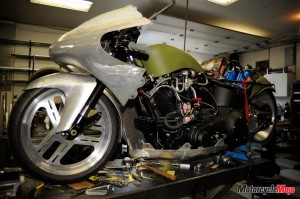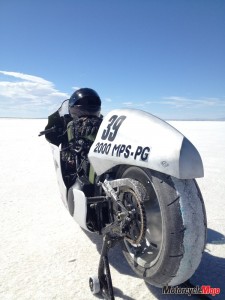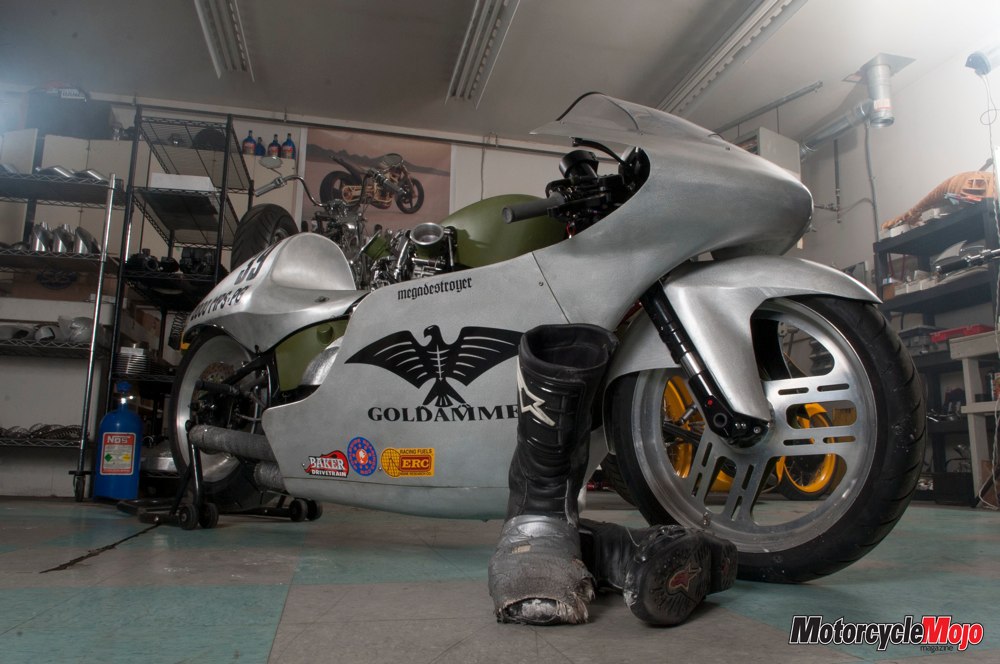 Everyone has a skeleton in the closet, and in the case of world-champion, custom bike builder Roger Goldammer, they come in the form of raw metal frames, hand-fabricated gas tanks and engine parts.
Everyone has a skeleton in the closet, and in the case of world-champion, custom bike builder Roger Goldammer, they come in the form of raw metal frames, hand-fabricated gas tanks and engine parts.
The wrought-iron gates were open as I arrived at the shop, hidden in the hills of the Okanagan Valley, British Columbia; escorting my truck up the winding driveway were four dogs that eventually sat by the driver-side door, waiting to introduce themselves. This would be a ritual during every subsequent visit I made over the course of the next year.
Goldammer is an artist. His name is spoken in the motorcycle world as the king of customs, and his many “crowns” stand on the shelves throughout his shop. Aside from his incredible artistry and expertise, he has a passion for speed. No, he doesn’t race flat track or superbike. In fact, he doesn’t compete in races at all. He does enjoy dirtbiking with his sons, but as for competing, his main competitor is himself.
Goldammer’s speed demons call him to Utah each year for the land speed record trials at the Bonneville Salt Flats. When I heard he was building a new Harley-Davidson–based racer specifically designed to exceed 200 mph, I had to meet the artist.
 “This build is simple in some ways,” stated Goldammer during our initial meeting in spring 2011. “I am starting out with an existing motorcycle versus hand-building everything. I am trying to do this one cost effectively.” By cost effective, Goldammer meant he would only use parts he had to spare – it was to be a bit of a recycling project, and one he looked forward to sharing with the “family” at Bonneville. “I had a spare engine lying around, so I built it up. It’s a pretty large, high-compression engine, naturally aspirated. I built an intake manifold from two downdraft carburetors, and I have two nitrous bottles in the tail section of the bike, and a lot of electronics.”
“This build is simple in some ways,” stated Goldammer during our initial meeting in spring 2011. “I am starting out with an existing motorcycle versus hand-building everything. I am trying to do this one cost effectively.” By cost effective, Goldammer meant he would only use parts he had to spare – it was to be a bit of a recycling project, and one he looked forward to sharing with the “family” at Bonneville. “I had a spare engine lying around, so I built it up. It’s a pretty large, high-compression engine, naturally aspirated. I built an intake manifold from two downdraft carburetors, and I have two nitrous bottles in the tail section of the bike, and a lot of electronics.”
As I was unfamiliar with the use of nitrous, Goldammer was happy to explain the many factors to consider, and as a seasoned veteran on the flats, he has enough experience to know exactly what he needs to make it happen.
Bonneville is fairly high up and has a density altitude of up to 7500 feet, so the air is pretty thin. “Nitrous works quite well; it’s good air in a bottle,” says Goldammer. “It really makes up for all the factors working against you. Rarely do you get a chance on a bike to go as fast as it will go, but when you hit that wall of air and the bike will not go any faster, you press that magic button and it just pulls you forward. You feel it in your whole body as it’s laid out across the bike. It’s atmosphere in a bottle – it creates really good air – but you don’t want to get too greedy.”
Modifying the bike for speed was first and foremost, but being an artist as well as a builder, Goldammer believed it should look good, too. “It had to have that creative, hand-crafted element,” he claimed. Starting with a bent frame, he replaced the backbone and downtubes, and explained how he “stretched the whole thing out somewhat.” He lowered the steering neck and put a short front end on it, making the bike more stable while reducing frontal area. Goldammer’s vision of the build consisted of hand-built aluminum bodywork, so he designed, cut, fabricated and installed the full fairing, the fenders and seat, and he intentionally left all bodywork in its bare, metal state.
 “When something is natural, you can see what it is made of,” he said. “There is no hiding anything; there’s no paint, no filler, and you can really see what it consists of . . . today, there are less and less hand-fabricated things around us.”
“When something is natural, you can see what it is made of,” he said. “There is no hiding anything; there’s no paint, no filler, and you can really see what it consists of . . . today, there are less and less hand-fabricated things around us.”
The bike also had to be built as low and as narrow as possible to reduce wind resistance. The downside of modifying a stock bike was that the normal foot position would not be possible without breaking out of the lean, narrow mold that land speed trials dictate. To compensate, Goldammer installed foot pegs closer to where passenger pegs are located. Therefore, the low seat positioning of a Harley Softail would have to be modified to a higher, custom-tailored position to accommodate the legs. Standard shifting would be complicated in this platform, so electronic shifting was installed. Once assembled and ready to go, 17-inch DOT race tires were chosen because they offer good grip and have some tread. A busy schedule kept Goldammer from trials before the flats on anything but a dyno, where the bike produced 203 hp.
At Bonneville, you get two miles to get your bike up to speed, and recording begins as you start the third mile. After completing the timed mile, nothing but real estate offers a controlled deceleration. Front brakes are optional on the flats, so Goldammer switched the rear brake control to the right handlebar. Once you’re out of the flying mile, you can take your time.
A trial run would have helped in 2011. The bike was handling and performing well on day one that year, running more than 200 mph during trials, as anticipated. On the third run, however, as he entered mile three, Goldammer recalls, “Things were going well; about three-quarters of the way through the run, I lost power. I pulled the clutch in and the oil filler plug hit my leg, which told me I may have lost a piston.”
He wouldn’t be certain what the problem was until the bike got up on a hoist under a tent in the hot sun. With several willing participants alongside to help diagnose the problem, Goldammer’s first inclination proved correct: a piston had let go. “If you’re going to blow up an engine, why not do it at 193 mph,” Goldammer said, laughing.
Barely back from that Bonneville attempt, his first priority was to tear the bike down for more modification. It would get a brand-new engine for 2012. The engine would still displace 120 cubic inches, but with a larger bore and shorter stroke. The idea was to build a stronger bottom end with a new flywheel assembly and beam connecting rods.
Goldammer put a lot of effort into the cylinder heads, welding the intake and exhaust ports, raising them 1.6 cm and angling them 20 degrees to increase airflow through the cylinder heads. Combustion chambers were also reworked to match the pistons. The changes were intended to make the bike more durable after the piston failure in 2011.
Goldammer played it safe in the first run of 2012, but while coming off the course on the return road, he heard a dreaded piston clatter and suspected it was over. “In the pits, I pulled the heads and one of the cylinders off, and I saw a major scoring on one of the pistons,” he recalled. Better prepared this time around, Goldammer had parts for a backup engine, and an entire day of rain allowed the crew time to replace the parts. However, they couldn’t get it working to the standards necessary to continue competition.
“This time, it was parts failure,” Goldammer said, recalling the 2012 attempt. “Very frustrating when there is only one chance per year to do it.
“There was a moment when I thought, after all that effort, the time and money, even modifying the rest of the bike to fit the new engine – I thought about not coming back, but that only lasted a few minutes.”
I asked Goldammer why he keeps going back.
“It is the place and people that bring you back, on top of the racing,” he said with a smile. “We had a good time down there; my friends who came down with me are the best, and the large family of racers and gearheads make it impossible to stay away.”
In addition to Goldammer’s many international awards for exceptional artistry and custom builds, there is another award he is reluctantly proud of. Tom “Santa Claus” Anderson gives an award every year to someone who has experienced a catastrophic engine failure at Bonneville. Goldammer had won it before, and he won it again in 2012.
Failure isn’t really failure at the Bonneville Salt Flats, but rather, it’s considered added experience; and without that experience, you can’t push your limits. According to Goldammer, it is one of the most hostile places on earth to compete. Bikes are exposed to very high loads for extended periods, with conditions changing from hour to hour. Risky combinations sometimes work, while trusted combinations sometimes fail.
As for 2013, Goldammer intends to trust his instincts, something he says he should have done in 2012. He plans to use the same type of pistons, but with a lot more clearance and special plastic buttons to keep the piston faces from actually touching the cylinder walls. It is a practice he’d resorted to years ago with Top Fuel Harleys. He didn’t do it this time around, because the piston maker advised him that it wasn’t necessary. “I basically took their word for it,” he reflected. “I didn’t go with my hunch, and I paid the price.”
I hope to attend the speed trials at the Bonneville Salt Flats in 2013 and watch Goldammer make another attempt to break a record.
“The machines down there are as diverse as the people,” says Goldammer. “It is just a crazy mix of engines and bikes of all types, from diesel-powered machines to converted dirtbikes to all-out production sportbikes to completely hand-built efforts. It is just really wonderful to be part of it, to keep that tradition going.”
















































